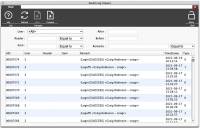Table of Contents
Mystic Help
Audit Log
The Mystic Audit Log can be found at [Staff Menu] > [Tools] > [Audit Log] and is designed for suitably authorised users to investigate the activity that is taking place on their Mystic installation and database.
 The [Audit Log] layout is very simple, consisting of a basic toolbar, a series of criteria which can be entered to reduce the number of the audit log entries retrieved, and the audit log entries themselves in a paged listing.
The [Audit Log] layout is very simple, consisting of a basic toolbar, a series of criteria which can be entered to reduce the number of the audit log entries retrieved, and the audit log entries themselves in a paged listing.
Whenever criteria are changed, use the [Refresh] toolbar icon to refresh the displayed list of audit log entries. To move back and fort between the list of identified audit log entries, use the [Back] and [Forward] toolbar icons.
Criteria
The criteria section allows the user to enter a series of search parameters which operate in a boolean [AND] manner (i.e. all criteria entered are combined together to determine whether an audit log entry should be displayed) in order to narrow down the audit log entries being displayed.
- User - Select an authorised staff user from the drop-down list to restrict entries which are directly attributed to that user.
- Reader - A word or phrase which matches elements of the reader record, being compared using the adjacent drop-down.
- Item - A word or phrase which matches elements of the catalogue record, being compared using the adjacent drop-down.
- After and Before - A date after which the audit-log records should be matched, before, or a combination of the two. The date should be entered in the standard international reverse-date format as used by the Structured Query Language (i.e. YYYY-MM-DD , YYYY-MM-DD HH:MM:SS etc.)
- Remarks A word or phrase which matches elements of the audit-log entry remark, being compared using the adjacent drop-down.
Audit Log Entries
Each audit log entry consists of seven (7) fields.
- UID - The unique database ID of the audit-log entry.
- User - The internal code representing the user responsible for the audit-log entry being created.
- Reader - Any reader which was directly affected by the audit-log action (e.g. A field in the reader record being changed). May be empty.
- Item - Any item which was directly affected by the audit-log action (e.g. a field in the item record being changed). May be empty.
- Remark - A description of the work done which raised this audit-log entry. The remark is formatted for later processing by reports and other functions.
- Time Stamp - The time stamp of what this audit-log entry was created.
- Type - An internal references to the type of activity being undertaken which raised this audit-log entry. This reference is used for further reporting and functional processing.
